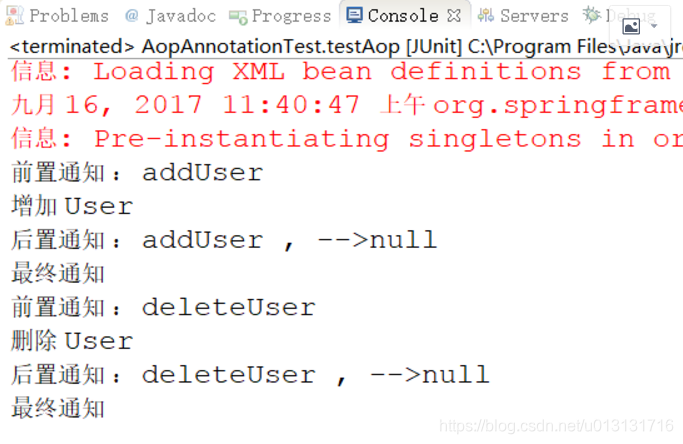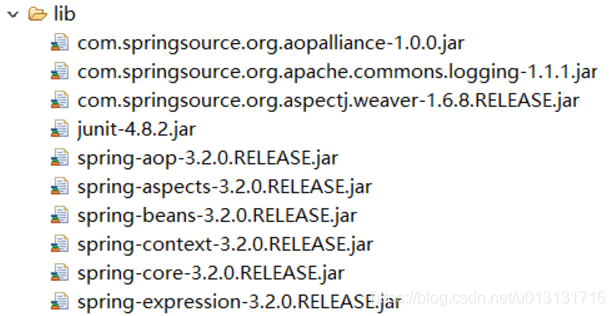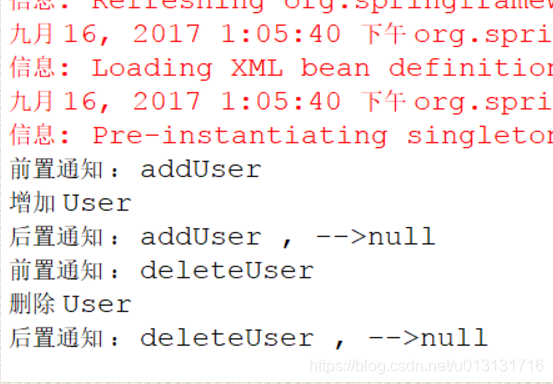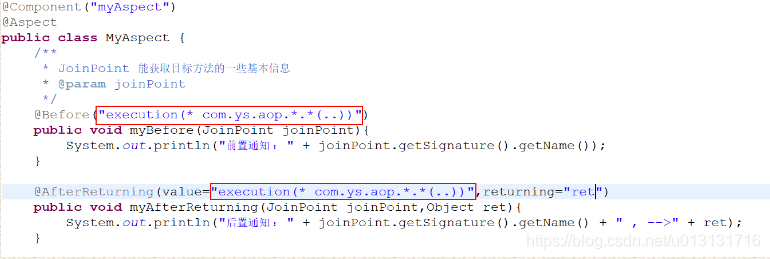原文网址:https://www.cnblogs.com/ysocean/p/7531083.html#_label0
目录
1、xml 的方式实现 AOP
2、注解实现 AOP
3、注解改进
4、总结
上一篇博客我们讲解了 AspectJ 框架如何实现 AOP,然后具体的实现方式我们是通过 xml 来进行配置的。xml 方式思路清晰,便于理解,但是书写过于麻烦。这篇博客我们将用 注解 的方式来进行 AOP 配置。
为了便于大家理解,讲解方式是这样的,我们先给出 xml 的配置,然后介绍如何通过 注解 来进行替代。
PS:本篇博客源码下载链接:http://pan.baidu.com/s/1dFdBHZF 密码:3v4k
1、xml 的方式实现 AOP
①、接口 UserService
package com.ys.aop;
public interface UserService {
//添加 user
public void addUser();
//删除 user
public void deleteUser();
}
②、实现类 UserServiceImpl
package com.ys.aop;
public class UserServiceImpl implements UserService{
@Override
public void addUser() { 、
System.out.println(“增加 User”);
}
@Override
public void deleteUser() {
System.out.println(“删除 User”);
}
}
③、切面类,也就是通知类 MyAspect
package com.ys.aop;
import org.aspectj.lang.JoinPoint;
public class MyAspect {
/** * JoinPoint 能获取目标方法的一些基本信息 * @param joinPoint /
public void myBefore(JoinPoint joinPoint){
System.out.println("前置通知 : " + joinPoint.getSignature().getName());
}
public void myAfterReturning(JoinPoint joinPoint,Object ret){
System.out.println(“后置通知 : " + joinPoint.getSignature().getName() + " , -->” + ret);
}
public void myAfterThrowing(JoinPoint joinPoint,Throwable e){
System.out.println("抛出异常通知 : " + e.getMessage());
}
public void myAfter(){
System.out.println(“最终通知”);
}
}
④、AOP配置文件 applicationContext.xml
<?xml version="1.0" encoding="UTF-8"?>
aop:config
<aop:aspect ref=“myAspect”>
<aop:pointcut expression="execution( com.ys.aop..(…))" id=“myPointCut”/>
<aop:before method=“myBefore” pointcut-ref=“myPointCut”/>
<aop:after-returning method=“myAfterReturning” pointcut-ref=“myPointCut” returning=“ret” />
<aop:after method=“myAfter” pointcut-ref=“myPointCut”/>
</aop:aspect>
</aop:config>
⑤、测试
@Test
public void testAop(){
ApplicationContext context = new ClassPathXmlApplicationContext(“applicationContext.xml”);
UserService useService = (UserService) context.getBean(“userService”);
useService.addUser();
useService.deleteUser();
}
⑥、控制台打印结果

上面的例子很简单,就是在 UserService 的 addUser()方法和 deleteUser()方法增加前置通知和后置通知,这在实际操作中很好理解。比如这是和数据库打交道的话,那么我们在 addUser() 或者 deleteUser() 时,必须要在前面开始事务,操作完毕后提交事务。下面我们就用注解的方式来配置。
2、注解实现 AOP
①、导入相应的 jar 包,以及在 applicationContext.xml 文件中导入相应的命名空间。这个在上面的源码下载链接中都有

<beans xmlns="http://www.springframework.org/schema/beans"
xmlns:xsi="http://www.w3.org/2001/XMLSchema-instance" xmlns:context="http://www.springframework.org/schema/context"
xmlns:aop="http://www.springframework.org/schema/aop" xsi:schemaLocation="http://www.springframework.org/schema/beans http://www.springframework.org/schema/beans/spring-beans.xsd
http://www.springframework.org/schema/aop
http://www.springframework.org/schema/aop/spring-aop.xsd http://www.springframework.org/schema/context
http://www.springframework.org/schema/context/spring-context.xsd">
</beans>
②、注解配置 bean
xml配置:
注解配置:
目标类:

切面类:

③、配置扫描注解识别
这个我们在前面也讲过,上面配置的注解,Spring 如何才能识别这些类上添加了注解呢?我们必须告诉他。
在 applicationContext.xml 文件中添加如下配置:
<context:component-scan base-package=“com.ys.aop”></context:component-scan>
④、注解配置 AOP
一、我们用xml配置过如下:

这是告诉 Spring 哪个是切面类。下面我们用注解配置
我们在切面类上添加 @Aspect 注解,如下:

二、如何让 Spring 认识我们所配置的 AOP 注解呢?光有前面的类注解扫描是不够的,这里我们要额外配置 AOP 注解识别。我们在 applicationContext.xml 文件中增加如下配置:
aop:aspectj-autoproxy</aop:aspectj-autoproxy>
三、注解配置前置通知
我们先看 xml 配置前置通知如下:
<aop:pointcut expression=“execution(* com.ys.aop..(…))” id=“myPointCut”/>
<aop:before method=“myBefore” pointcut-ref=“myPointCut”/>
那么注解的方式如下:

四、注解配置后置通知
xml 配置后置通知:
<aop:after-returning method=“myAfterReturning” pointcut-ref=“myPointCut” returning=“ret” />
注意看,后置通知有个 returning=“ret” 配置,这是用来获得目标方法的返回值的。
注解配置如下:

五、测试
@Test
public void testAopAnnotation(){
ApplicationContext context = new ClassPathXmlApplicationContext(“applicationContext_Annotation.xml”); UserService useService = (UserService) context.getBean(“userService”);
useService.addUser(); useService.deleteUser(); }
六、控制台打印结果

3、注解改进
我们可以看前置通知和后置通知的注解配置:

注意看红色框住的部分,很显然这里是重复的,而且如果我们有多个通知方法,那就得在每个方法名都写上该注解,而且如果包名够复杂,也很容易写错。那么怎么办呢?
解决办法就是声明公共切入点:
①、在 切面类 MyAspect.java 中新增一个切入点方法 myPointCut(),然后在这个方法上添加 @Pointcut 注解

②、那么前置通知和后置通知,我们可以进行如下改写配置:

4、总结
上面我们只进行了前置通知和后置通知的讲解,还有比如最终通知、环绕通知、抛出异常通知等,配置方式都差不多,这里就不进行一一讲解了。然后我们看一下这些通知的注解:
@Aspect 声明切面,修饰切面类,从而获得 通知。
通知
@Before 前置
@AfterReturning 后置
@Around 环绕
@AfterThrowing 抛出异常
@After 最终
切入点
@PointCut ,修饰方法 private void xxx(){} 之后通过“方法名”获得切入点引用








 本文详细介绍了如何使用注解实现面向切面编程(AOP),包括前置通知、后置通知等,并提供了从XML配置到注解配置的转换过程,以及如何声明公共切入点以简化配置。
本文详细介绍了如何使用注解实现面向切面编程(AOP),包括前置通知、后置通知等,并提供了从XML配置到注解配置的转换过程,以及如何声明公共切入点以简化配置。
















 1094
1094

 被折叠的 条评论
为什么被折叠?
被折叠的 条评论
为什么被折叠?








